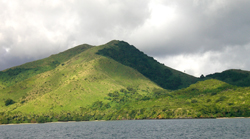 |
| Gau Island |
Aug 11th, 2007 - Aug 17th, 2007
Gau Island has a fringing reef on its north and east coasts with a barrier reef off its west and south coasts creating a large lagoon. Our study site was the fringing reef off the north-west coast. We studied two zones of this fringing reef, one inside a recently declared Marine Protected Area (MPA), the other just outside the MPA.
Gau Island is located 90 km east of Fiji’s largest island, Viti Levu. The land, its fringing reef and the lagoon/barrier reef system are managed as a whole. Gau and its waters are divided into 18 regional communities. The study site for our data was located in the waters off the northwestern community of Qarani.
 |
| Slash and burn practices |
The north and northwest coasts are protected from the south east trade winds which blow from April/May to September/October.
A major bleaching event, possibly from increased water temperatures, occurred in Fiji in 2000, decimating an average of 40-80% of hard corals throughout the islands. (Sykes 2007) Gau Island was adversely affected from the bleaching event and damaged even further by outbreaks of crown of thorns stars in 2001 and 2002. These afflictions were observed specifically by Helen Sykes at the site Anthias Avenue, just inside the pass on the northwest side of the lagoon but were most likely affecting many other parts of the Gau reef system. Recently there has been amplified concern of the sustainability of Gau’s fish and invertebrate populations.
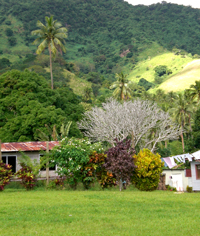 |
| Sawaieke village |
This was a particularly appropriate time to collect data just off Qarani because it represents a baseline data set inside and just outside the recently established MPA. Frontier Fiji have a research programme based on the west side of the island and are conducting underwater surveys around the island. We hope that there are marked changes in these data sets over time as the effects of protecting the area become evident.
The water temperature averaged 75.7°F (24.3°C), with the highest recorded temperature 78.8°F (26°C) and the lowest 71.6°F (22°C).
Bleaching observations were minimal at 0.4% inside the MPA and 0.9% outside.
 |
| Lethal Orange Disease |
Observations of White Band Disease occurred sporadically throughout the study site. This affected table Acropora colonies and was a possible cause of completely dead table Acropora colonies noted. Also observed was one incidence of Lethal Orange disease, in this case wasting coralline algae to leave exposed coral rock.
Horizontal visibility measurements were taken four times during the course of the study using a Secchi disk with an average value of 92 feet (30.7 metres). Nine vertical measurements gave an average value of 74.6 feet (24.9 metres).
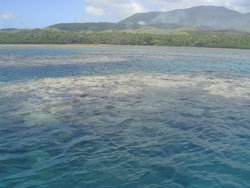 |
|
Reef topography at surface
showing ridges separated by channels |
The fringing reef just off Qarani and the northwest coast of Gau extends as a reef flat which is exposed at low tide. The reef edge drops vertically to a depth of 3-4 metres. This edge is generally rich in coral cover. The reef then forms a series of coral ridges running perpendicular to the coastline with channels of rubble, rock and sand in between. The tops of these ridges are generally rich in coral cover and are in a depth of less than 1 metre at low tide. This formation of ridges and channels continues down the reef slope before dropping off into deep water. The surrounding waters reach depths of 200 metres.
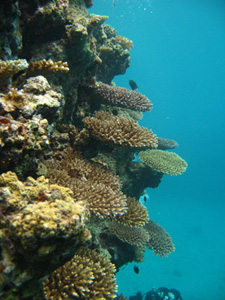 |
| Dense coral cover on ridges |
We collected data within the Marine Protected Area and outside the Marine Protected area. Interestingly, the MPA zone is slightly lower in overall health than the non-MPA zone - 52.5% and 58.6% respectively - and the overall threat is higher in the MPA zone than the non-MPA zone - 35.8% and 29.1% respectively. The Vitareef dives within the MPA zone included three dives just in front of Qarani village. Here we found a higher sediment load, both in the water column and on the corals themselves, causing death of the underlying tissue. There was also more macro and filamentous algae present in this area, most likely due to a lack of sewage treatment in the village. These three dive sites are recessed into the bay, compared with the rest of the Vitareef dive sites, both inside and outside the MPA, which are on the seaward areas of the reef.
There are areas on this reef where large swathes of corals have died at least several years ago, possibly during the bleaching event of 2000. Young colonies are also establishing themselves along this reef. Acropora spp. is the dominant coral genus, particularly on the shallow reef top areas.
On the first transect dive a giant moray eel guarded a coral bommie, surrounded by schools of chromis. Two-spine, regal and lemon peel angelfish were present on each of the four transect dives. No sharks were observed during the course of this study. Few large predatory fish were observed and all groupers sighted were small, maximum 12 inches. From SV Infinity we observed many birds feeding in deeper water off the reef, indicating schools of fish present. On two occasions, schools of fusiliers were seen and lone jacks made a few appearances on the study site.
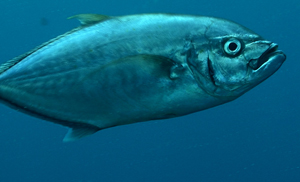 |
| Jack |
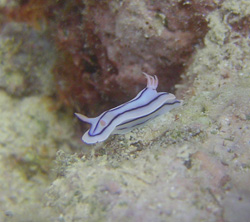 |
| Chromodoris lochi |
Inside the MPA, there was a wide variety of soft corals that overtook much of the reef, but the most abundant were Sarcophyton spp. and Lobophyton spp. Outside the MPA, the same soft corals were present but not in as high abundance. A pin cushion star, Culcita novaeguineae, was found inside the MPA. The MPA had sea urchins, the dominant species being Echinostrephus spp. 85% of the sea cucumbers observed during this study were found within the MPA and over 50% were of the Bohadschia species. All of the observed giant clams were outside the MPA. One corallivorous snail, Conus marmoreus, was found outside the MPA and was approximately 5 cm in length.
According to local reports, dolphins are often seen feeding outside the reef. On one occasion during the study we heard cetaceans during a dive and the dive tender observed a pod of Pilot whales passing very close to the reef. They appeared to be feeding.
Turtles were observed on four separate occasions during dives both inside and outside the MPA. All were Hawksbill turtles, between 50 and 80 cm in length.
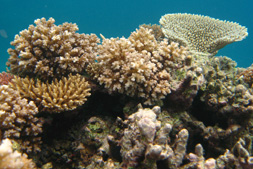 |
| Reef shallows |
In general it can be said that the site studied is showing signs of recovery from past events which have affected its health and vitality. This is particularly evident on the reef flats and reef crests where table Acropora spp. dominate. The area of reef studied close to the village was definitely more affected by sediment and algae than the outer reef areas. We observed fires burning on the land during the first days of the study. This creates exposed soil that is easily washed off into the shallows where it tends to smother living coral. A lack of sewage management is the most likely cause for overgrowth by macroalgae.
 |
| Octopus |
We would like to thank everyone at the University of South Pacific for their assistance in enabling us to carry out this study in Gau, in particular, Dr Joeli Veitayaki, Dr Bill Aalbersberg and Dr Ken MacKay. We would also like to thank our friends in Gau Island who helped us during our time there.